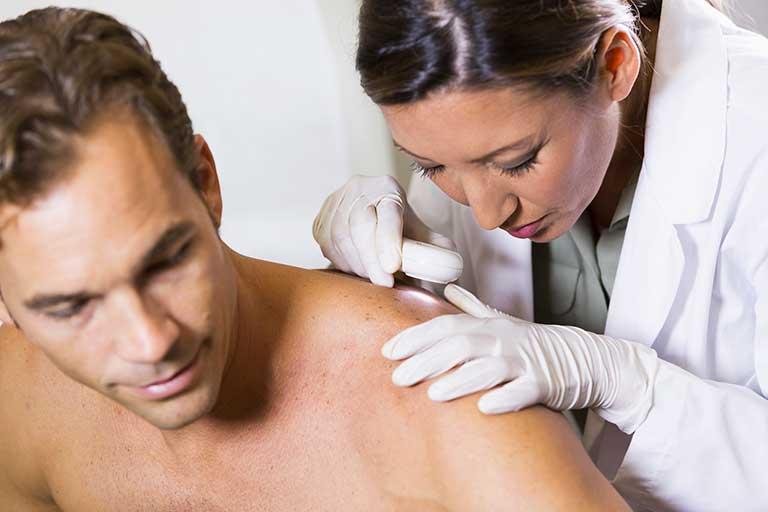Skin Cancer: Symptoms and Treatments

What is skin cancer?
Skin cancer is caused by an abnormal overgrowth of skin cells that have lost control over their own growth cycle. In most cases, it is due to ultraviolet radiation-induced alterations accumulated by skin cells whether by excessive or unprotected sun exposure or the use of sunbeds.
Skin cancer is the most common type of cancer, representing one third of cancer diagnoses worldwide.
There are three main types of skin cancer: basal cell carcinoma, squamous cell carcinoma and melanoma. Also, actinic keratosis is a form of precancerous skin growth that can develop into a cancer.
Skin cancer diagnosis
It is important to have regular examinations by a specialist doctor or dermatologist since it has not been proven that self-examinations of the skin can determine this type of cancer. Still, it is important to be familiar with the spots or marks present on our skin to detect any changes and make sure a dermatologist takes a closer look at them. The ABCDE rule can help us distinguish a normal mole from one that is not:
- Asymmetry: One half of the mole doesn't match the other.
- Border irregularity: The mole shows uneven, irregular, blurred or jagged edges.
- Color: The most dangerous colors are reddish, whitish and blueish on blackish-color lesions.
- Diameter: Moles with a diameter greater than 6 mm and/or that have grown bigger since last measurement.
- Evolving size, shape or color: Follow up and monitor moles and, if one changes size or shape, ask your doctor.
Your dermatologist will perform a visual examination, although this will not constitute a final diagnosis. If the mole in question shows malignant characteristics, a biopsy will confirm or rule it out.
How to prevent skin cancer?
The main risk factor of skin cancer is exposure to ultraviolet radiation, either emitted by the sun or by sunbeds. Prevention is particularly important for people with low phototypes, i.e. lighter skin, but it is important for all types of skin.
It is recommendable to take any measures to prevent excessive exposure. Current recommendations to avoid skin cancer are:
- Wear clothes (long pants or long-sleeve shirts), hats and sunglasses during sun exposure.
- Use protective sunscreen.
- Avoid sun exposure for long periods of time, especially in the central hours of the day (between 12 p.m. and 4 p.m.) when solar radiation is higher.
Topical treatments with chemotherapeutic, immunomodulatory and photodynamic agents can be also used to treat multiple field subclinical lesions and decrease the risk of subsequent cancer development.
Skin cancer treatments
Skin cancer treatments vary based on the type of involvement and stage of the disease - surgical removal being the most commonly used. It is extremely effective and generally well tolerated, with very high healing rates, especially for superficial carcinomas. In the case of very small tumors with low risk of recurrence, cryotherapy can also be applied, which consists in freezing tumorous cells to kill them.
When it is not possible to use other types of techniques, topical treatments with chemotherapeutic, immunomodulatory and photodynamic agents, which are very useful in superficial tumors, can be used. Electrosurgery and radiotherapy are also effective for this type of cancer, particularly in cases of carcinomas with large-size tumors. In most aggressive cases, usually in melanoma, systemic chemotherapy is necessary. We currently are seeing great advances in immunotherapy treatments for this type of skin cancer.
In any case, regular dermatological monitoring is important to detect a potential recurrence.
Bibliography
- Skin Cancer Foundation. Skin Cancer Facts & Statistics [Internet]. 2020 Jan 31. Available at: https://www.skincancer.org/skin-cancer-information/skin-cancer-facts/
- Skin Cancer Foundation. Skin Cancer Prevention [Internet]. 2020. Available at: https://www.skincancer.org/skin-cancer-prevention/
- Jacobe, H., Chien, A. Risk Factors. Skin Cancer Foundation [Internet]. 2019 Jun. Available at: https://www.skincancer.org/risk-factors/
- Skin Cancer Foundation. Self-Exams Save Lives [Internet]. 2020. Available at: https://www.skincancer.org/early-detection/self-exams/
- Halpern, A.C., Marghoob, A.A., Reiter, O. Melanoma Warning Signs. Skin Cancer Foundation [Internet]. 2019 Apr. Available at: https://www.skincancer.org/skin-cancer- information/melanoma/melanoma-warning-signs-and-images/#abcde
- Skin Cancer Foundation. Mohs Surgery [Internet]. 2020. Available at: https://www.skincancer.org/treatment-resources/mohs-surgery/
- Skin Cancer Foundation. Treatment Glossary [Internet]. 2020. Available at: https://www.skincancer.org/treatment-resources/treatment-glossary/
- Prevent Cancer Foundation. Save Your Skin [Internet]. 2020. Available at: https://www.preventcancer.org/programs/save-your-skin/
- American Cancer Society. How to Do a Skin Self-Exam [Internet]. 2019 Jul 23. Available at: https://www.cancer.org/healthy/be-safe-in-sun/skin-exams.html
- Christensen, S.R. Recent advances in field cancerization and management of multiple cutaneous squamous cell carcinomas. F1000Res [Internet]. 2018;7. Available at: https://www.ncbi.nlm.nih.gov/pmc/articles/PMC5989149/. doi: 10.12688/f1000research.12837.1.
